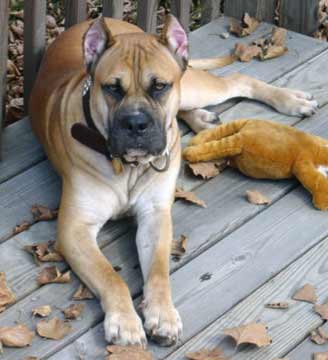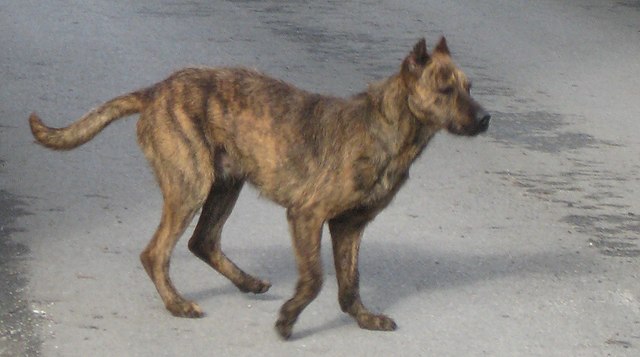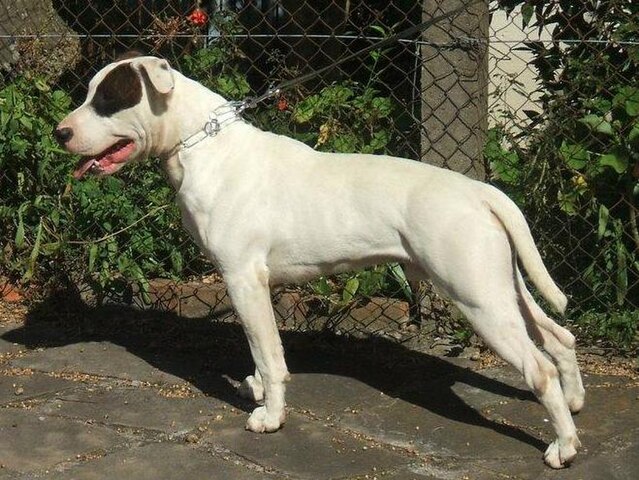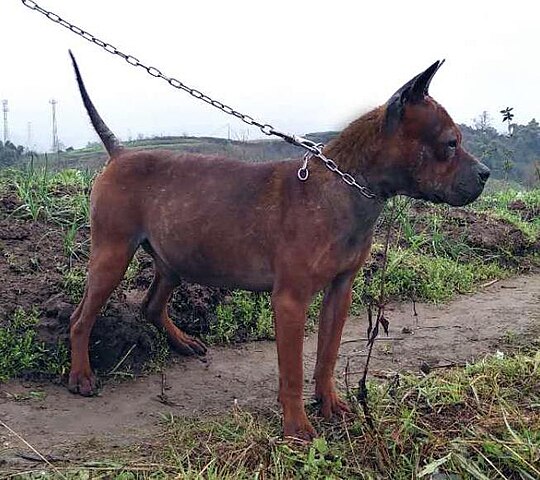The Spanish Bulldog (AKA Alano Espanol or Spanish Alano) is in the background of numerous molosser breeds including the Bulldog, the Mastiff and the Dogue de Bordeaux to name just a few! An ancient breed, he is most known for the role he played in the royal Spanish army although was also used as a cattle dog, guard dog, bullfighter, and for hunting. At one point quite popular, he had been owned and written about by numerous poets, authors, historians and playwrights of old. Unfortunately, as guns became more advanced and plentiful, the role of this breed as an army dog declined and numbers began to drop. Combined with the importation of other “exotic” breeds from other countries saw the population decline even more. In the early 1980’s, interested parties sprang up to revive the breed including a project from the University of Cordoba, and the breed was saved and eventually recognized by the Royal Spanish Canine Society in 2003.
Spanish Bulldogs tend to be naturally dominant and need owners that are dog-savvy. That said, when proper rules are put in place they are respectful of those rules and the people that enforce them. They should have balanced and reliable temperaments when raised correctly, and furthermore can be trained to be quite obedient. They are naturally loyal don’t need a harsh hand in order to learn. In fact, as long as the owner is firm yet fair, this breed is likely to respond even to a whispered command! This is a thinking breed that excels when given a job to do, whether it be a high-impact sport or even put to work as a therapy dog – a job which they tend to shine in.
Spanish Bulldogs are a lively breed that love to play and be affectionate toward their owners! While normally reserved around strangers, if well socialized and taught to love new people they can become quite social. The same can be said for other animals – growing up around other pets will teach them to enjoy being part of a multi-species pack. This breed was often used to hunt in packs and are therefore often good around other dogs although it should be noted that if another dog starts a fight they won’t back down. They can also be good with children as they are quite patient. Finally, they are quiet dogs that don’t tend to bark excessively which makes them easier to live with in more urban areas. Not only do their friendly natures set them apart from similar related breeds, they are also not prone to drooling – an added plus! 
Spanish Bulldogs are very athletic and do well in active households. The breed can jump amazing distances, even from a standstill, as well as display all sorts of acrobatic feats including climbing trees! They definitely require an owner that can keep up. This dog enjoys a lot of time outdoors and would be a good match for an owner that is equally outdoor-centric. Never being bred for appearance, they were instead bred to withstand tough and rugged environments and as such, are exceptionally hardy and healthy. Known for doing well in all manner of climates, this is also one of the rare breeds that can do surprisingly well living outside – although being so social, it is not recommended to keep them in the backyard with little human contact. This loyal breed loves spending time with his family and additionally needs a lot of structured exercise to boot.
It should come as no surprise due to his background that the Spanish Bulldog makes an excellent guard dog, and he will stop at nothing (save for his owner’s command) to pursue his target. Imbued with a high pain tolerance, he was known to fight to the death when going after a target – even in pursuit of a wild animal such as a bear or boar! His large robust build, strength and naturally protective instinct make him great at this job, although it is worth noting that he should not be unduly aggressive for no reason. Most of the time, his confidence is all that is needed to warn away a potential threat but he won’t hesitate to do what needs to be done if he feels his owner is in danger.
The key physical traits of the Spanish Bulldog include a brachycephalic, square head with a wide and strong skull. The muzzle is short and has no wrinkles, covering a very well developed jawbone. The teeth should be big and separated from each other, and fit into an inverted scissors bite. The ears are traditionally cropped, and are set far apart from each other on the head. The neck is short and wide, and the skin underneath forms a slight double dewlap. The topline is straight and may slightly incline toward the rear. The tail is long and thick at the root, tapering as it reaches the end. The gait of the breed is unusual and should resemble that of a large feline with a low-carried head. Colors include brindle, fawn, or black/brindle, with or without small white markings and/or a black mask.



